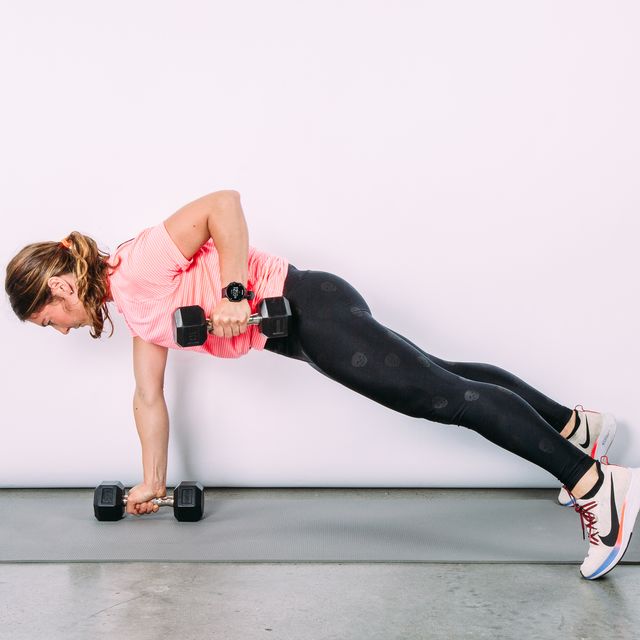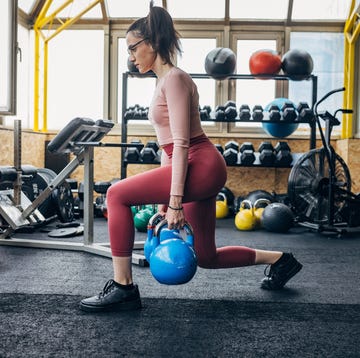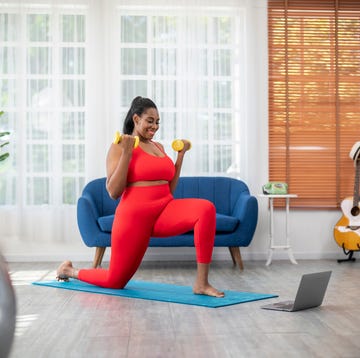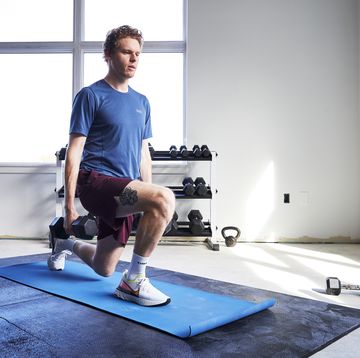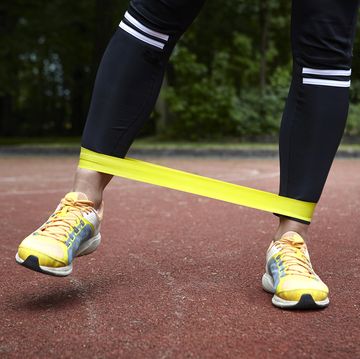Bodyweight exercises provide the perfect path to a beginner strength routine. But when you’re ready to take your resistance exercises to the next level, a dumbbell workout is the way to go—especially with these six exercises that target key running muscles and test your body in new ways.
“Strength training, even with simple dumbbells, helps create a more durable athlete,” says Sam Tooley, founder of Alpha Fit Club and The Garage Gym in New Jersey. “As runners, we are constantly putting stress on our bodies by pounding the pavement and pushing our limits—the more equipped our body is to handle that stress, the more likely we are to stay healthy and injury-free.”
The Benefits of a Dumbbell Workout for Runners
By using dumbbells and challenging your muscles with heavier weights, you train your body to handle an additional load. “That stress is something your body has to combat and adapt to in order to grow stronger,” says Tooley. “If you’re just doing bodyweight movements, you’re missing out on a ton of bang for your buck that you’d get with properly executed weight work.”
That extra weight also helps target issues in form and posture. “From slouched shoulders to an arched back, shortening of stride to heel-striking, these weaknesses show up when fatigue begins to set in,” says Tooley. “The stronger foundation we give ourselves, the easier maintaining our form and posture will be in those latter stages of a grueling race or workout.”
How to use this list: Jess Movold, Runner’s World+ Coach demonstrates the moves below so you can learn the form. Perform 3 sets of these exercises for the number of reps listed below. And aim to do the workout twice a week. For best results, hit the weight room after high-quality runs or cross-training sessions to ensure you spend recovery days doing exactly that: recovering.
1. Dumbbell Deadlift
Why it works: This move targets the hamstrings and lower back, two constant problem areas for runners, says Tooley. “A deadlift focuses on engaging the hamstrings throughout the duration of the movement,” he explains. As you slowly fold forward to actively stretch the muscle, you’re fighting the force of weight; as you stand back up to start, you contract the muscle to pull that weight back up. “Controlling this stretch and squeeze of the hamstring is incredibly beneficial for building strength in your legs for the latter stages of a race,” says Tooley.
How to do it:
- Stand with feet hip-width apart, holding dumbbells in front of hips, palms facing thighs.
- Hinge at the hips by sending butt straight back and bend knees slightly to lower dumbbells along the front of legs, pausing when torso is parallel to the ground.
- Drive through the midfoot to return to stand, keeping dumbbells close to the body throughout. Fully extend hips and knees, squeezing glutes at the top. That’s one rep.
- Perform 10 reps. Repeat for 3 sets total.
2. Weighted Step-Up With Knee Drive
Why it works: Thanks to our day jobs, most runners’ have weak hips and limited knee drive. “The step-up focuses on explosive power in the hips and quads,” says Tooley. It also mimics the running motion, but adding weights makes it more challenging. “By opening up your hips and focusing your knee drive, you’ll feel more explosive in each stride.”
How to do it:
- Stand in front of a step or bench, holding a dumbbell in each hand.
- Step up with right foot, then drive the left knee up toward your chest so hip and knee form a 90-degree angle.
- Return to start.
- Repeat. Do 8 reps on each side. Repeat for 3 sets total.
3. Overhead Press
Why it works: “Our shoulders and arms are far more crucial to our running than most people understand,” says Tooley. A strong upper body increases your ability to maintain posture and keep propelling yourself forward when you’re tired—as you slow, pumping your arms harder can actually help you move faster. “Focusing on our ability to pull and press with force helps build that upper body strength for when we’re under stress,” he says.
How to do it:
- Start with dumbbells racked at shoulders, palms facing in. Press the dumbbells overhead until arms are straight, standing tall throughout.
- Return to shoulders.
- Repeat. Do 10 reps. Repeat for 3 sets total.
4. Bent-Over Row
Why it works: If you’re doing this move properly, everything from the hamstrings and hips to the entire back and core should be engaged, which improves your stability. “Stability under stress is crucial for an endurance athlete,” says Tooley. “Explosive movements like this teach our body to remain stable when all it wants to do is bend and fold; you’re not only increasing physical strength, but promoting proper posture and form under stress, like during a race.”
How to do it:
- Start standing, with a micro-bend in knees and two dumbbells in hands, palms facing in.
- Hinge forward at the hips so arms hang perpendicular to floor.
- Bend elbows to pull weights up to ribs, drawing shoulder blades back and down.
- Straighten arms back down.
- Repeat. Do 10 reps. Repeat for 3 sets total.
5. Renegade Row
Why it works: “The core is our center, it controls everything that happens,” says Tooley. If you’re all wobbly in your core, you run the risk of over-rotating and wasting energy on your arm swing while you’re running. “The less energy we waste, the more our body can focus on propelling itself forward—and in running, that’s the entire goal.”
How to do it:
- Start in a high plank position, hands on dumbbells, wrists under shoulders, feet in a wide stance.
- Keeping hips steady, pull one dumbbell up to rib cage, creating a 90-degree angle with your elbow.
- Return dumbbell to floor and repeat on the other side. Continue alternating for 16 reps. Repeat for 3 sets total.
6. Weighted Glute Bridge
Why it works: Your stride starts in your pelvis and glutes, and “hip bridges ignite your posterior chain from your hamstrings to your glutes,” says Tooley. And “if you’re lacking in posterior chain strength, your risk for injury rises.” Hip bridges without a weight are great, but becoming comfortable and confident with an additional load only increases the benefits, he adds.
How to do it:
- Start lying faceup on the mat with knees bent, feet flat on floor, holding one or both dumbbells across hips.
- Press through heels to lift hips up toward ceiling.
- Pause, then slowly lower back down.
- Repeat. Do 15 reps.

